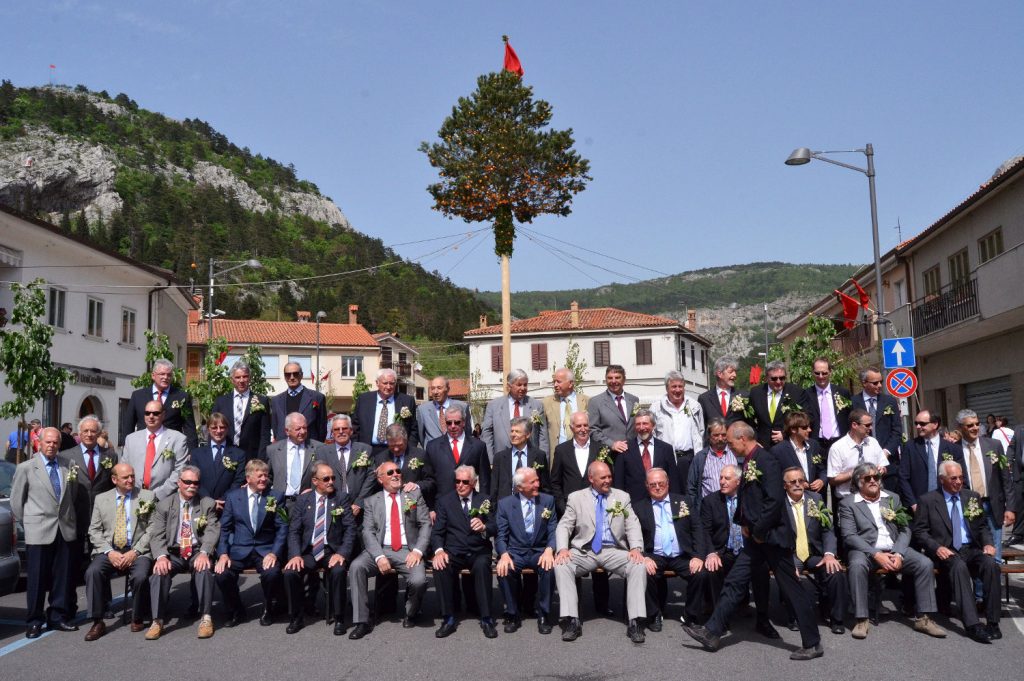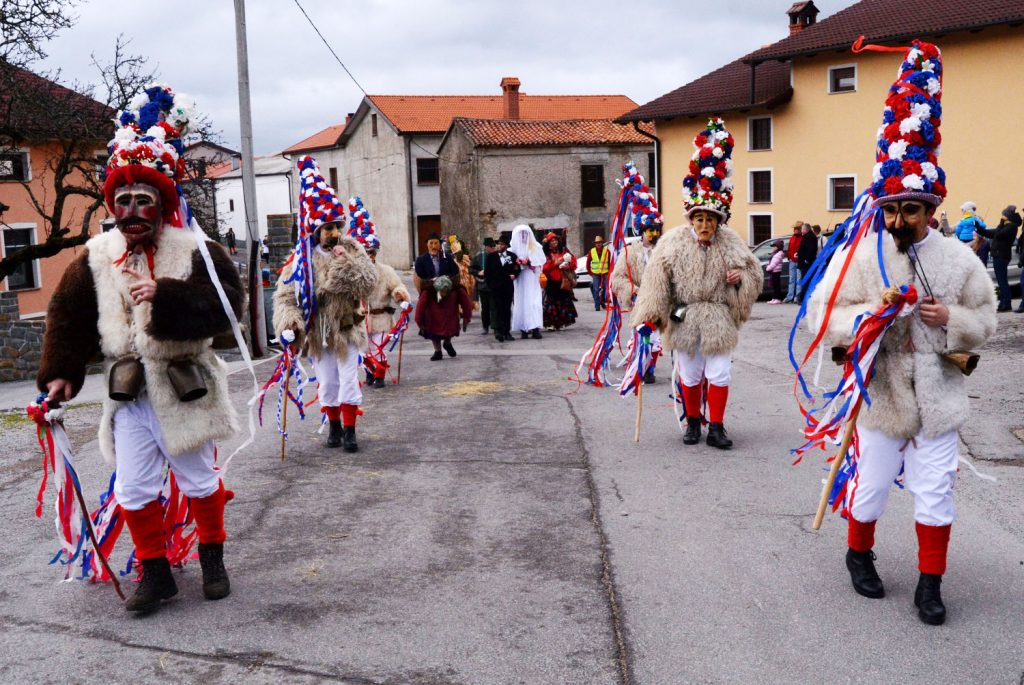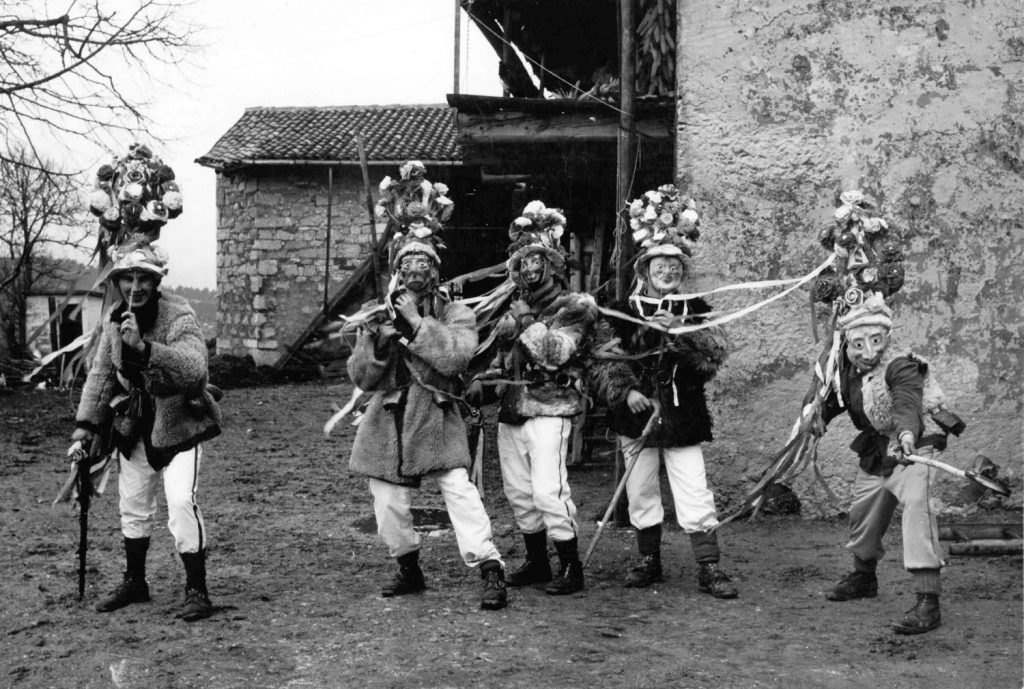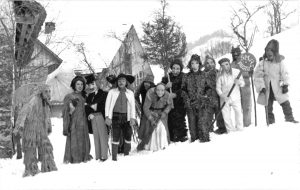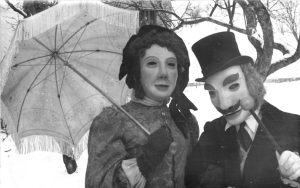Jurij Fikfak
The relationship between the researcher and the performer is never resolved and is never clear. It is characterized by the dynamics of desires, expectations, and demands from both sides. Just like researchers in the past, modern researchers of folk life and cultural practices face the issue of what they actually see when exploring a specific phenomenon. Namely, many performers provide the researcher with a picture of a harmonious and an ideal-type cultural practice, with which they seek to draw attention to a previous harmony. In this way, the researcher can become caught up in the images of the world that the performer uses to present and shape the village or community identity, and to capture a moment in time. On the other hand, the researcher can unveil the context of unevenness that his research is taking place as a self-representation of the local community and its important representatives.
Eisch & Hamm (2001), who explore the history of ethnology and anthropology, argue that researchers used to write conventional texts with a typical homogenizing harmony, which, however, failed to capture the unevenness of everyday reality (2001, 13). One could agree with the opinion that evidently speaks of the basic position of researchers at that time, for whom the first point of departure was not to reflect on their own positions or those of the interlocutor. At the same time, in the researcher’s opinion, it seems that the researcher and the person studied (that is, the testifier of folk life) spoke at least to some extent within the same self-evident horizon and that they shared the same image of the world, whereby the subject of the study and expert report simply focused on other issues, unevenness, ambiguities, and differences. The researcher and the interlocutor together sought or found an image of the world that can be referred to as aurea aetas — that is, a world with no disharmony of everyday reality, which the editors discussed in their work dedicated to Utz Jeggle, a professor at the Ludwig Uhland Institute for Empirical Cultural Studies in Tübingen, where this basic dichotomy was first addressed as an ethnological research subject. Today it is taken for granted that any phenomenon is studied by taking into account that anomalies exist in everyday reality, and it is also taken for granted that researchers self-reflect on their position and research procedure; this has become an imperative for any thorough research.
Eisch & Hamm’s claim can of course also be understood as simplification because in the past overlooking a certain unevenness of reality, while focusing on its “evenness,” in many respects agreed with the ethnologist’s concept and desire to appropriately understand and depict folk heritage. In this regard, the question can be posed whether this was about the researcher’s desire only. It is first necessary to establish what anomalies the researcher of that time was actually interested in, how communication took place, how the researcher viewed the performer, and at what levels he needed one. In short, the issue of the relationship between the interlocutor and the researcher is about the meeting of first- and second-order constructions, common-sense viewpoints, everyday life, and scholarly discourse (Schutz 1962) on the one hand, and the development of both positions on the other. During the 1960s, a period characterized by the Tübingen farewell to folk life in particular, the horizons of both common sense and research changed dramatically.
The desire for harmony also largely functioned as the desire of the population, which performed a specific ritual practice in which it found its authentic time and space, which it also communicated to the researcher as such. There came to pass not only what Pierre Bourdieu (1978) anticipated—that interlocutors only say what the researchers want to hear — but also that interlocutors primarily told what they wanted not only the researcher, but also the public, to hear, so that the settlement studied could confirm its local identity. When they told the researcher about a specific ritual model, about “how they used to celebrate in the old days,” they talked about an ideal-type self-realization of the settlement and the harmonious image of a non-problematic village; in this way they tricked the researcher into doing what he had most likely implicitly wanted to do himself: to study the phenomenon of the ritual itself.
Figure 1: May 1st celebration in Boljunec (Bagnoli della Rosandra): male community in front of the May tree with the red flag. 1. 5. 2013. Photograph: Jurij Fikfak.
Figure 2: Ribbons with the colors of the Slovenian flag: Škoromati meeting in Pregarje near Hrušica (Brkini Hills), 15. 2. 2014. Photograph: Jurij Fikfak
Figure 3: Group “Škoromati”. Performing ritual “Škoromatija”. Hrušica 1962. Photograph: Božo Štajer.
However, this narrated authenticity is also bound to the narrator himself and to his current predominant ideological horizon. For instance, one could ask since when the ribbons of a certain group (for instance, the škoromati, a traditional carnival group in Southwestern Slovenia, in the Brkini Hills) have been tricolor and represent the Slovenian flag? Since when has a red flag been used at the top of maypoles in the Slovenian villages across the Trieste coastal region?
Narrators sought and staged the authentic chronotope — that is, the time1 and place of the ritual — whereas the researcher sought the authentic or true image of the ritual. According to Ivan Lozica (1989, 37), in doing so, the researcher removed the temporal and spatial contexts from a specific phenomenon and made its oldest known form — one could say “Urtext” — authentic. On the other hand, by analogy with collecting folk stories and folk songs, the researcher could search for the original text or the ritual proto-text. However, in seeking the golden age of the ritual, he overlooked not only its modern version, but also its context: that is, reality with all of its unevenness, and all of its hybridity of old and new, in which a ritual occurs or sometimes does not.
However, this also resulted from the fact that, for the active participants, the ritual is a special occasion in and of itself. According to Carl S. Hale, this is a Gaian time, which refers to the cycles of the Earth and life, the seasons, and different periods in people’s lives:
“This time dimension touches us on a very deep level: where the generations meet, where the past and the future fructify in the present moment, where the experience. For ultimately, Gaian time roots us in the transpersonal dimension beyond our own lifetime, past, present, and future, and links us to our family, our ancestors, society, history, nature, and the cosmos. The Gaian dimension . . . is itself an authentic temporal experience.” (Hale 1993, 94)
At the same time, another phenomenon must be highlighted: within the Stakhanovite and cooperative communist ideology of five-year plans, especially for people in rural areas, rituals represented an exit or a holiday; they had internalized them deeply even before the political and systemic changes after the Second World War and passed them on to their children. Within this horizon, the rural population perceived the research interest of an outsider as an affirmation of its world and value system (cf. Fikfak 1999, 2004; Portis Winner 2002) in contrast to the cooperative and other nationalization measures that encroached on rural freedom and power. However, for a researcher that at that time dedicated himself to the issues of customs and traditions of the “old world” with great professional zeal, it was understandable that he was interested not only in socially engaged ethnological writing, which would have affirmed the existing system, but that he also viewed this world as one of the last islands free of ideology.
There is another possible explanation: the ethnologists exploring the nineteenth century largely experienced their primary socialization in the countryside and their secondary socialization in an urban environment, usually far from home. Therefore, they hardly ever problematized their childhood experiences and preserved them as one of their most authentic experiences of rituals and time. Something similar has occurred over the past twenty years, with narrations about old times depicting people’s lives and rituals that the narrators experienced fifty or more years ago and that simply no longer exist today. In this regard, the childhood image is an imagination of the authentic ritual, which they can now only imitate, but no longer an experience.
A person that has lost this feeling of time actually misses the life sources of rootedness and meaning in his life (Hale 1993, 94). This last assertion by Hale2 draws attention to the fact that some people experience this ritual time as very stressful and they cannot wait for it to pass; therefore they do not want to participate in it and help shape it, but they prefer to appear only as observers or passersby, which is quite difficult in a village environment, which uses covert sanctions. However, an ambivalence can be perceived with many of them — that is, a need for the members of the carnival group (škoromati) to visit their house and a simultaneous great fear that they might do something unpredictable or irreparable, such as affect the observer too much (e.g., smear him with charcoal) or break something in the house. These observers have another problem: the škoromati in smaller villages (such as Javorje, Obrov, Gradišče pri Materiji, and so on) — where they are not organized into such solid groups as in Hrušica and Podgrad, where only the poberini (a group of three or four men gathering gifts) come to every house—follow to a much lesser extent an established schedule of visits, so that a housewife may wait several hours for the poberini and the rest of the carnival group. This further increases her displeasure because on the one hand she feels the desire and obligation to play along with the ritual (i.e., to receive the škoromati) in order to avoid potential criticism from the village community, and on the other hand she is afraid of any possible (even though not very likely) escapades by certain drunk members of the carnival group.
Fig. 4: Group “Cerkljanski laufarji”.
Reconstruction of the ritual “Laufarija” in 1956.
Cerkno. Photograph: Božo Štajer.
Fig. 5: Cerkno, Lady and Gentleman.
Reconstruction of the ritual “Laufarija” in 1956.
Photograph: Božo Štajer.
The image of a ritual properly carried out agrees with the villagers’ desire for an ideal-type image and harmony, even though today nearly all of them are also aware of or have greatly internalized the fact that harmony no longer exists and simply cannot exist anymore. During the 1950s and 1960s, when Niko Kuret, the greatest Slovenian ritual specialist, began his research, people still preserved the memory of harmony in significantly more predictable and settled relationships typical of patriarchal life, despite the relatively repressive former communist system. The memory was a desire or simply a possibility of something else. This desire was especially prominent at the end of the 1950s and the beginning of the 1960s, when enormous changes were introduced in the countryside, from tractors and media (radio and television) to industrial production. This was a period of intense deagrarization and urbanization, when all working-age people left to work in factories for various reasons and factories became the main socializing factor, also by limiting the opportunity to engage in ritual folk culture practices to Sun-days only. This was the time that most likely changed the traditional image of folk culture the most and redefined the image of the workday; the worker’s or part-time farmer’s schedule changed and became more demanding. In exploring carnival practices (the groups in Cerkno, Ptuj, the Brkini Hills, and so on), Kuret (1984, 1997) may have recorded one of the last images of this disappearing harmony or images of a countryside not yet touched by industry, and images of a world in which time was significantly more difficult to define, less binding or closed than the time dictated by the factories. However, without a detailed analysis of his records, it remains unclear whether Niko Kuret searched for this harmony and also asked about it. For now, it can be concluded that to some extent he was still theoretically and methodologically bound to the questions that encouraged him to revive the folk theater in the 1930s, that enabled him to reconstruct certain carnival practices (in Cerkno, the Brkini Hills, and so on) in the 1950s and 1960s, and that ultimately reaffirmed the harmony itself through their answers.
According to Hans-Georg Soeffner, in the ritual — this special practice that Kuret investigated and defined with the help of Saint-Exupéry’s The Little Prince — the everyday nature of shared social life is transcended in at least three ways, which indirectly respond to the question why during the carnival season people in all the places I have explored accept every outsider that shows interest in the carnival as their own. Soeffner argues that in experiencing a ritual one can speak of:
1. A transcendence of an individual experience through the evidence of an illusion of a collectively presented inter-subjectivity. This is about fulfilling the desire for a “higher community” that actually functions merely as an idea and content;
2. A transcendence of an individual space and scope that is presented through collective cooperation as part of the community body and soul, and represents a monument to the community; and
3. A transcendence of time and the past, with the illusion that a ritual retains or preserves time in order to ensure a permanent presence of the “higher community” and subsequently preserve the evasive experiences of the community. (Soeffner 1992, 118–119)
In this regard, the function of interested outsiders (either researchers in the 1960s or 1970s, or today’s photographers and journalists) is to capture moments in time. They use beautiful images — which overlook or conceal the often conflict-laden discourse about who is important in the village and who has the power to make decisions — to capture a space for posterity, turning the recorded community into something special. Thus, the locals keep asking me: “Are you a reporter? Are we going to be in the newspapers tomorrow? Or on TV?”3
These outsiders seem to be especially important when they can provide some publicity: thus, for example, a few years ago the main organizer of the škoromatija carnival ritual in one of the villages first turned his attention to a team of journalists among the several choices available (a researcher, the public, and journalists); that is, he turned to the one that could provide the greatest publicity possible. Photographers are also important when they provide the locals with an image that they never would have thought of themselves, making them special. With their publications, the outsiders mark a special place in time for the local residents or some sort of a memorial refuge (“This was back when we were on TV” and so on); in addition, they also mark the time of the groups traveling elsewhere, especially abroad (to Italy, Poland, and so on).
However, all of this is not merely about seeking the harmony of time. One of the more important spatial dimensions is searching for and ensuring one’s place in the collective, or the harmony in the collective, which is reproduced in various ways, such as by replying in the plural. It is very common for people to reply to questions about their personal experiences of a ritual in the plural: “we did that,” “we went,” “we arranged,” and so on. This means they translate their personal experience into a plural or collective one. Considering Soeffner’s claim about transcendence as the basic feature of a ritual, this of course raises questions about whether this experience can primarily even be defined as individual.
By posing the question “When did you all go?” to the interviewee, his reply is almost automatically limited to a collective experience. Nonetheless, the carnival and škoromatija do not exist merely as a collective fact. The questions to which first-person replies were provided included, for instance, “What costume did you (as an individual) wear?” “How many times have you worn a costume?” and “How and when were you accepted into the young men’s community?” However, even in this case the replies depended on the narrator and his role in the ritual. With the organizers, initiators, and main performers of a ritual practice — that is, the ones that were either in charge of carrying out the ritual practice or those that served as the community’s spokesperson to the public—the replies were almost always internalized and included the collective “we.” It can be concluded that an individual’s narration about his experience, whether in a collective or singular form, primarily depends on the manner of his inclusion in the ritual. A first-person reply or saying “they go” primarily shows that a person is distancing himself from the ritual phenomenon.
Based on everything discussed, and the constant drawing closer and apart, it is possible to better understand the issues faced by former researchers and their writing methods. To some degree, they represent a mutual desire for harmony or at least for recollecting the golden age. The narrators accomplished this through their narrations, whereas the researchers recorded the ideal-type reception of the ritual and put it in words as an ideal-type production, whereby in many cases they sought to effectuate it by reconstructing the ritual practice.4
Harmony has remained nothing but a breath, or as Frank Underwood, the main protagonist of the TV series House of Cards, puts it:
“I . . . (long pause) . . . I wish I could describe . . . Harmony.
That’s the word that stuck in my mind.
Harmony. It’s not about what’s lasting or permanent.
It is about individual voices coming together.
For a moment. And that moment lasts . . . The length of a breath.”
(Frank Underwood, House of Cards, Season 1, Episode 8)
References
Bourdieu, Pierre. 1978. ‘Postface’, in Reflections on Fieldwork in Morocco, by Pierre Bourdieu (Berkeley, CA: University of California / Princeton Press).
Eisch, Katharina, & Marion Hamm. 2001. ‘Einleitung’, in Poesie des Feldes. Beiträge zur ethnographischen Kulturanalyse, edited by Katharina Eisch and Marion Hamm (Tübingen: Tübinger Vereinigung für Volkskunde) = Untersuchungen des Ludwig-Uhland Instituts 93, pp. 11-23.
Fikfak, Jurij. 1999. ‘“In principi je bila Basida” – in njen po-ustvarjalec’, Traditiones 28 (1), pp. 29-34.
Fikfak, Jurij. 2004. ‘From Ethnography to Autoethnography’, in Qualitative Research: Different Perspectives, Emerging Trends, edited by Jurij Fikfak et al. (Ljubljana: Založba Inštit. za Slovensko Narodopisje ZRC SAZU et al.), pp. 75-90.
Glasser, William. 1985. Positive Addiction (New York: Perennial Library).
Hale, Carl S. 1993. ‘Time Dimensions and the Subjective Experience of Time’, Journal of Humanistic Psychology 33 (1), 33 issue: 1, pp. 88-105. DOI: http://dx.doi.org/10.1177%2F0022167893331006
Ingold, Tim (ed.). 1996. Key Debates in Anthropology (London: Routledge).
Kuret, Niko. 1984. Maske slovenskih pokrajin (Ljubljana: Cankarjeva založba).
Kuret, Niko. 1997. Opuscula selecta. Poglavja iz ljudske kulture (Ljubljana: SAZU).
Lozica, Ivan. 1989. ‘Aurea Aetas’, in Folklore and Historical Process / Folklor i povijesni process, edited by Dunja Rihtman-Auguštin and Maja Povrzanović (Zagreb: Institut za etnologiju i folkloristiku), pp. 33-40.
Portis-Winner, Irene. 2002. Semiotics of Peasants in Transition. Slovene Villagers and Their Ethnic Relatives in America (Durham, NC: Duke University Press).
Soeffner, Hans Georg. 1989. Auslegung des Alltags — Der Alltag der Auslegung. Zur wissenssoziologischen Konzeption einer sozialwissenschaftlichen Hermeneutik (Frankfurt am Main: Suhrkamp). = Suhrkamp Taschenbuch Wissenschaft 785.
Soeffner, Hans Georg. 1992. Die Ordnung der Rituale. Die Auslegung des Alltags 2 (Frankfurt am Main: Suhrkamp). = Suhrkamp Taschenbuch Wissenschaft 993.
1. In his definition of time, Hale (1993) distinguishes between authentic and inauthentic time. From a very simplified perspective, his definition could be understood along the lines that authentic time is the time that involves self-oblivion of time. Thus, in terms of ritual experience, or at least some of its most active participants, it can be concluded that the time of the ritual is authentic time, a time of belonging to the collective, a time of forgetting oneself and one’s problems; William Glasser (1985) may have referred to this time as uncritical time. I am using the term “authentic space” as a complement to authentic time because this is a space in which something unquestionable or self-evident can happen or in which something can even happen in the first place. For instance, for traditional Slovenian carnival groups such as the škoromati, this authentic space consists of their home village or settlement, where they can act just that single day or just for this occasion within the “village negotiated and accepted frame of excess”. In contrast to this “private” event, the space of their visiting performances in various places is when they must exercise self-control; they must control their behavior because they are representing their village or settlement to the public, to the outside world.
2. For Hale, a clinical psychologist and neuropsychologist specializing in various forms of learning problems in children, religious experience is one of the most important forms of self-realization.
3. Here I would like to mention two photojournalists that were the most important recorders of ritual practices in the Trieste region and that have unfortunately already passed away: Mario Magajna and Davorin Križmančič. Among other things, people in the Trieste area largely organized and practiced their ritual customs to allow their performances to reach the target readership of the Slovenian newspaper Primorski dnevnik through both of these photographers.
4. Despite the very different viewpoints and premises, the interwar period, or the period following the catastrophe of the First World War, can be described as a period of seeking and a need for a new man. Niko Kuret’s work, especially the part focusing on folk theater, was also motivated within these frameworks. Imbued with the ideas of ruralism, he searched for sources in folk material, especially the passion plays (the Škofja Loka Passion Play and Drabosnjak’s passion play) that he could use to stir the Slovenian people to return to Christianity. After the war, the motivations for reviving folk tradition were reflected in his extremely successful endeavors and work surrounding the reconstruction of numerous carnival practices and other features of cultural heritage.
